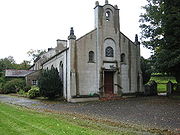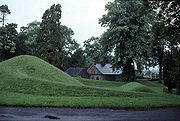
Kilwarlin Moravian Church
Encyclopedia

John Cennick
John Cennick was an early Methodist and Moravian evangelist and hymnwriter. He was born in Reading, Berkshire, England to an Anglican family and raised in the Church of England....
following a Moravian mission in Ireland that began in Dublin in 1746. Kilwarlin is a small village near Hillsborough in County Down.
History
John Cennick, who was a teacher at the Moravian School for the children of miners in KingswoodKingswood, South Gloucestershire
Kingswood is an urban area in South Gloucestershire, England, bordering the City of Bristol to the west. It is located on both sides of the A420 road, which connects Bristol and Chippenham and which forms the high street through the principal retail zone...
, worked alongside John Wesley
John Wesley
John Wesley was a Church of England cleric and Christian theologian. Wesley is largely credited, along with his brother Charles Wesley, as founding the Methodist movement which began when he took to open-air preaching in a similar manner to George Whitefield...
in the evangelical revival in the Bristol area of England. He subsequently became a Minister of the Moravian Church. In 1746 he was sent to Dublin to preach in an evangelical campaign in Ireland. This work resulted in Moravian societies in counties Antrim
County Antrim
County Antrim is one of six counties that form Northern Ireland, situated in the north-east of the island of Ireland. Adjoined to the north-east shore of Lough Neagh, the county covers an area of 2,844 km², with a population of approximately 616,000...
, Down
County Down
-Cities:*Belfast *Newry -Large towns:*Dundonald*Newtownards*Bangor-Medium towns:...
, Londonderry
County Londonderry
The place name Derry is an anglicisation of the old Irish Daire meaning oak-grove or oak-wood. As with the city, its name is subject to the Derry/Londonderry name dispute, with the form Derry preferred by nationalists and Londonderry preferred by unionists...
, Armagh
County Armagh
-History:Ancient Armagh was the territory of the Ulaid before the fourth century AD. It was ruled by the Red Branch, whose capital was Emain Macha near Armagh. The site, and subsequently the city, were named after the goddess Macha...
, Tyrone
County Tyrone
Historically Tyrone stretched as far north as Lough Foyle, and comprised part of modern day County Londonderry east of the River Foyle. The majority of County Londonderry was carved out of Tyrone between 1610-1620 when that land went to the Guilds of London to set up profit making schemes based on...
, Cavan
County Cavan
County Cavan is a county in Ireland. It is part of the Border Region and is also located in the province of Ulster. It is named after the town of Cavan. Cavan County Council is the local authority for the county...
and Donegal
County Donegal
County Donegal is a county in Ireland. It is part of the Border Region and is also located in the province of Ulster. It is named after the town of Donegal. Donegal County Council is the local authority for the county...
.
Cennick founded the Kilwarlin congregation in 1755 and built a church for it. In 1759, the congregation purchased some land for a burial ground. There was also a Manse for the Minister's residence. About eighty people attended the church. However, by 1834 the buildings were in ruins and only six members remained.
Kilwarlin's renewal came with the arrival of a new Minister. This was a man called Basil Patras Zula.
Zula, born in 1796, was a Greek chieftain who had fought in the War of Independence against the Turks. The Turkish commander put a price on Zula's head and this together with subsequent ambushes appears to have induced a nervous state of mind for the remainder of the latter's life. He spent some time hiding in Italy but in 1822 returned to Greece to take part in the siege of Missolonghi. The slaughter revolting him, he went to Smyrna where he met an Englishman, Sir William Eden. Eden returned to England in 1828 taking Zula with him and from there the two men went to Ireland.
In Dublin, Zula met a Moravian school teacher called Ann Linfoot who knew Greek and was able to converse with him. Linfoot invited Zula to attend services at the Bishop Street Moravian Church in Dublin. Joining the congregation, Zula eventually offered himself for service as a Minister of the Moravian Church and was accepted. In 1829 he married Ann Linfoot and in 1834 the couple accepted a call to serve the Kilwarlin congregation.

When rebuilding Kilwarlin Manse, Zula incorporated 'a number of escape mechanisms - two doors in all the downstairs rooms, two separate staircases and outside at the back a small room built on stilts with a trap-door leading to a hiding place under the floor'. Zula never had to put these devices to use and in fact died naturally in Dublin on 4 October 1844. His body was brought back to Kilwarlin for burial. His widow Ann continued to live in the Manse and ran a boarding school for 'Select Young Ladies' until her own death in 1858.
A curious feature of Kilwarlin Moravian Church is that Zula, at his own expense, had the grounds landscaped to represent the terrain of the ancient Battle of Thermopylae in which the Spartan army saved Athens from attack by the Persians. Most of the landscaping still remains.

